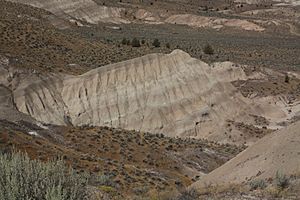Mascall Formation facts for kids
Quick facts for kids Mascall FormationStratigraphic range: Hemingfordian-Barstovian ~20.4–13.6Ma |
|
|---|---|

Outcrop near Picture Gorge
|
|
| Type | Sedimentary |
| Underlies | Rattlesnake Formation |
| Overlies | John Day Formation |
| Area | John Day Valley, Fox Basin |
| Thickness | 2,000 feet (610 m) |
| Lithology | |
| Primary | Sandstone, conglomerate |
| Location | |
| Extent | eastern Oregon |
| Type section | |
| Named for | Mascall Ranch (south of Dayville) |
| Named by | J. C. Merriam |
| Year defined | 1901 |
The Mascall Formation is a special layer of rocks found in eastern Oregon, in the Western United States. It formed during a time called the Miocene epoch, many millions of years ago.
This formation is named after the Mascall Ranch, which is south of Dayville, Oregon. Scientists study the Mascall Formation to learn about ancient environments and the animals that lived there.
Contents
What is the Mascall Formation Made Of?
The Mascall Formation is mostly made of sedimentary rocks. These rocks formed from bits of sand, mud, and ash that settled down over time. It can be as thick as 2,000 feet (about 610 meters)!
You can find different types of rocks here:
- Sandstone: This rock is made from tiny grains of sand that were cemented together.
- Ash and Tuff: These come from ancient volcano eruptions. Volcanic ash settled in water, forming light-colored rock called tuff.
- Conglomerate: Imagine a rock made of many different pebbles and larger stones stuck together. That's conglomerate! The stones in the Mascall Formation's conglomerate are often rounded, like they were tumbled in a river.
Special Volcanic Rock Layers
Within the Mascall Formation, there's a unique layer called an ignimbrite. This rock forms from hot, fast-moving flows of volcanic ash and gas. It's mostly made of tiny pieces of volcanic glass.
Scientists have found small amounts of other minerals in this ignimbrite. These include quartz (a common mineral), magnetite (a magnetic mineral), and zircon.
How Old is the Mascall Formation?
Scientists can figure out the age of rocks using special methods. They found that the ignimbrite layer in the Mascall Formation is about 13 million years old. This means the rocks formed during the middle of the Miocene epoch.
Some parts of the Mascall Formation are mixed with layers from the Columbia River Basalt Group. This group is made of huge amounts of basalt rock, which came from massive volcanic eruptions.
Ancient Life: Fossils Found Here
The Mascall Formation is famous for its fossils! Scientists have discovered many vertebrate fossils here. Vertebrates are animals with backbones, like mammals, birds, and reptiles.
These fossils tell us about the animals that roamed Oregon millions of years ago. The fossils found here belong to a time period called the Barstovian. This was a time when many different types of ancient mammals lived, including early horses, camels, and rhinoceroses.


